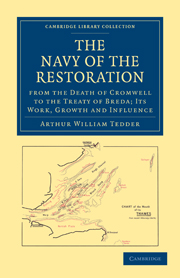 The Navy of the Restoration from the Death of Cromwell to the Treaty of Breda
The Navy of the Restoration from the Death of Cromwell to the Treaty of Breda Book contents
CHAP. II - THE NAVY AND THE STUART RESTORATION
Published online by Cambridge University Press: 07 October 2011
Summary
Neglected as was the history of the Navy until the latter end of the last century, ignorance had resulted in an almost absolute non-recognition of the influence of the fleet upon the Restoration and the intrigues and negotiations accompanying it. The more modern refusal to recognise that influence is, however, less comprehensible. It is possibly true that merely as an armed force the fleet “could only apply pressure by intercepting trade and cruising outside ports,”—by blockade “in circumstances which made effective blockade impossible” but as a moral force the Navy was far from being negligible on either side of the Channel. There were simple reasons for this. In England after the death of Cromwell every party, every political force, had lost half its power through divisions and dissensions; there was the Army against the Parliament, Lambert against Monk, the Rump against the ‘Secluded Members,’ minor sect against minor sect, petty faction against petty faction, until no man knew where to turn for authority and there was no ‘power’ in the land. The one exception to this rule of chaos and disunion was the Navy. There were of course differences of opinion, of belief, among officers and men; there are plenty of signs that all shades of opinion, from royalist to republican, were represented in the fleet; but the important fact is that opinions seem to have had no effect on discipline as regards the fleet as a whole.
- Type
- Chapter
- Information
- The Navy of the Restoration from the Death of Cromwell to the Treaty of BredaIts Work, Growth and Influence, pp. 15 - 38Publisher: Cambridge University PressPrint publication year: 2010First published in: 1916
